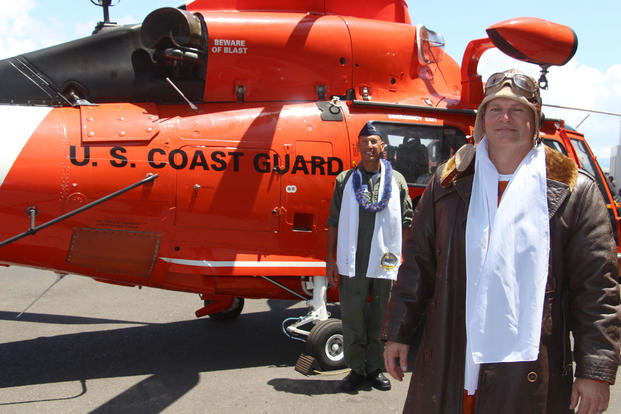HONOLULU — Master Chief Petty Officer Michael Ferreira passed on the title of Enlisted Ancient Albatross to Master Chief Petty Officer Clay Hill, during a change of watch ceremony at Coast Guard Air Coast Guard Air Station Barbers Point, Thursday.
Vice Adm. Charles W. Ray, the Coast Guard’s Pacific Area commander and the Coast Guard’s Ancient Albatross, presided over the ceremony recognizing the passing of the title from one enlisted aviator to another to honor the Coast Guard enlisted aircrew member on active duty with the earliest graduation date from an aviation technical school.
Ferreira, originally of Portsmouth, Rhode Island, and the former command master chief for Coast Guard Air Station Sitka, Alaska, retired July 30 after 30 years of service.
“It has been an honor and privilege to serve as the ninth Enlisted Ancient Albatross,” said Ferreira. “Coast Guard aviation is truly outstanding for too many reasons to list. The fine men and women who maintain and crew our aircraft are certainly at the very top of that list as are all of the folks who support Coast Guard Aviation. Next year in 2016, Coast Guard aviation will celebrate its 100th anniversary. There is no doubt in my mind that through the next 100 years, Coast Guard aviation is in good hands and will continue to set the example for professionalism and remain an integral part of the world’s finest Coast Guard.”
Prior to retiring, Ferreira logged more than 4,250 flight hours on the Coast Guard HC-130 Hercules airframe. Other assignments include Air Station Barbers Point, Air Station Clearwater, Fla., Air Station Miami and Air Station Cape Cod, Massachusetts, where he was received the distinction of being the ninth Coast Guard Enlisted Ancient Albatross.
Hill is currently serving as the Coast Guard aviation survival technician rating force master chief at Coast Guard Headquarters in D.C. His primary responsibility is to ensure members are stationed at the appropriate units and are capable of executing or supporting Coast Guard missions. His most recent assignments were the command master chief at Air Station Barbers Point and at the Coast Guard Aviation Training Center in Mobile, Alabama.
“I am honored to assume the title of the Coast Guard Enlisted Ancient Albatross,” said Hill. “This position represents the culmination of my aviation career and I am proud to represent the Coast Guard's enlisted air crewmembers. I am excited to meet with the Coast Guard's distinguished current and former aviators and air crewmen to share our aviation legacy.”
Hill hails from Alma, Georgia, and enlisted in the Coast Guard in 1983 and graduated from Coast Guard Aviation Survivalman “A” School in 1988. Hill served on multiple platforms as a rescue swimmer including the HH-3F Pelican helicopter, HH-60 Jayhawk helicopter, HH-65 Dolphin helicopter and as a flight mechanic on the Dolphin. Hill holds a bachelor’s degree in professional aeronautics from Embry-Riddle University.
In 1966 and 1988 the Coast Guard Ancient Albatross and then the Enlisted Ancient Albatross Awards were established respectively to honor the Coast Guard aviators on active duty who has held that designation for the longest period. These awards recognize the great contributions our most senior aviators and enlisted aircrew make to the strength and vitality of the Coast Guard’s superior aviation fleet.
The Coast Guard operates more than 200 aircraft from 26 air stations. Modern helicopters and fixed-wing aircraft provide state-of-the-art support for the entire range of the Service’s missions including search and rescue, homeland security, law enforcement, and marine environmental protection. More than 3,000 pilots, mechanics and technicians keep the fleet of aircraft flying safely.
Related Video:


























